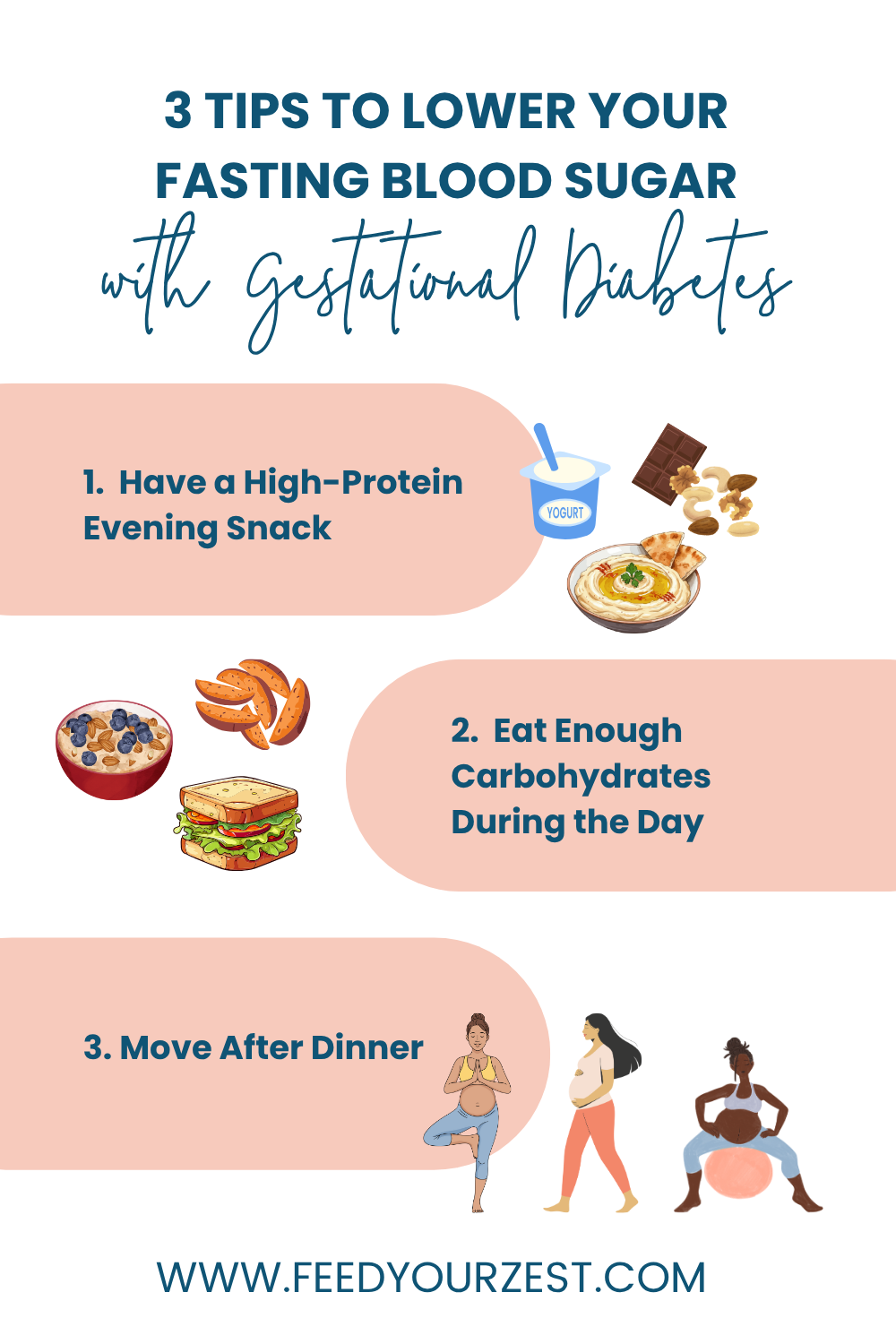3 tips to lower your fasting blood sugar with GD
Pregnancy is an exciting time! If you’ve been diagnosed with gestational diabetes (GDM), it can also come with new questions about food, blood sugar, and what your numbers mean.
Pregnant folks with diabetes commonly see higher fasting blood sugar in the morning, even when they haven’t eaten since dinner.
If that sounds familiar, you might be experiencing something called the Somogyi effect, A.K.A the dawn phenomenon. Let’s break it down in simple terms and talk about three nutrition strategies that can help you wake up with steadier glucose levels.
What Is the “Dawn Phenomenon”?
The dawn phenomenon is a natural rise in blood sugar that happens in the early morning hours (typically between 4–8 a.m.)
It’s caused by your body’s normal hormonal rhythm.
As you sleep, hormones like cortisol, growth hormone, epinephrine, and glucagon start to rise when you are getting ready to wake up. Their job is to signal your liver to release sugar (glucose) into your bloodstream, giving your body energy to wake up and get moving.
For most people, insulin quickly balances that morning sugar release. But during pregnancy, the body becomes more resistant to insulin due to certain hormones released by the placenta, especially if you have gestational diabetes. This means that glucose can stay higher for longer, which is why your fasting blood sugar may read above target when you first check it in the morning.
Why It Matters
Consistently elevated fasting glucose can affect both maternal and fetal outcomes, so managing it is key. The good news? With the right nutrition strategies, you can often help keep those numbers in check. So let's go through them!
3 Tips to Lower Your Fasting Glucose
1. Have a High-Protein Evening Snack
A balanced bedtime snack can make a big difference for fasting glucose. When you go more than 10 hours without eating, your liver releases extra glucose overnight to prevent your blood sugar from dropping too low. Ironically, that “safety mechanism” can raise your fasting levels instead.
A small snack before bed (within 2 hours of sleep) helps your body maintain steady fuel overnight, reducing the need for that liver-driven sugar release.
Aim for 10–20 grams of protein and include a complex carbohydrate if it fits your meal plan. Everyone’s response is a little different, so you can experiment with or without the carb portion to see what keeps your readings most stable.
Snack ideas:
Apple Slices with Peanut Butter
Crisp apple slices paired with creamy peanut butter for a satisfying mix of carbs and protein.
Berry Protein Parfait
Layer Greek yogurt with mixed berries and a spoonful of high-fiber granola.
Protein “Cookie Dough”
Greek yogurt mixed with a small scoop of peanut butter, oats, and a few dark chocolate chips for a sweet, balanced bite.
Whole-Grain Crackers with Cheese
A few whole grain crackers like triscuits paired with some slices of swiss cheese
Whole-Grain Pretzels with Hummus
Crunchy whole-grain pretzels dipped in creamy hummus for a balanced blend of complex carbs and plant-based protein.
2. Eat Enough Carbohydrates During the Day
It might sound counterintuitive, but skimping on carbs during the day can raise fasting blood sugar later.
When you eat too few carbohydrates, your body can interpret it as an “energy shortage.” To compensate, the liver releases more glucose into your bloodstream – especially overnight.
That’s why most gestational diabetes meal plans include consistent, moderate carbs at each meal and snack. Spreading them evenly throughout the day helps prevent spikes and dips that can trigger those early morning rises.
Strategies:
Choose high-fiber carbs (like oats, beans, fruit, and starchy vegetables like sweet potato).
Pair carbs with protein and fats (like nuts, eggs, or avocado).
Avoid skipping meals, even if you’re busy. Your body needs steady fuel.
3. Move After Dinner
A little movement after your evening meal can go a long way in improving both post-meal and fasting blood sugar levels.
Even 10–15 minutes of light activity — like walking around your neighborhood, tidying up, or standing while folding laundry. This helps muscles use glucose for energy and keeps blood sugar from lingering high before bed, which can also influence morning readings.
Try:
A gentle walk after dinner
Doing dishes while standing
A short yoga video
The Bottom Line
If you notice higher morning numbers with gestational diabetes, don’t panic! The dawn phenomenon is common and completely manageable. With a few strategic changes like adding a high-protein evening snack, spreading carbs evenly throughout the day, and moving after dinner, you can often see improvement in just a few days.
Remember: Everyone’s body responds differently. Partner with your dietitian to fine-tune your meal plan and monitor what works best for you and your baby.
You’ve got this! One balanced meal (and bedtime snack!) at a time.
Want more help making food choices that work for you and your baby? Our dietitians can help! Schedule your appointment today.
Sources:
O'Neal TB, Luther EE. Dawn Phenomenon. [Updated 2023 May 16]. In: StatPearls [Internet]. Treasure Island (FL): StatPearls Publishing; 2025 Jan-. Available from: https://www.ncbi.nlm.nih.gov/books/NBK430893/
Salis, Sheryl1,; Vora, Natasha1; Syed, Shefa1; Ram, Uma2; Mohan, Viswanathan3. Management of Gestational Diabetes Mellitus with Medical Nutrition Therapy: A Comprehensive Review. Journal of Diabetology 12(Suppl 1):p S52-S58, July 2021. | DOI: 10.4103/jod.jod_44_21

